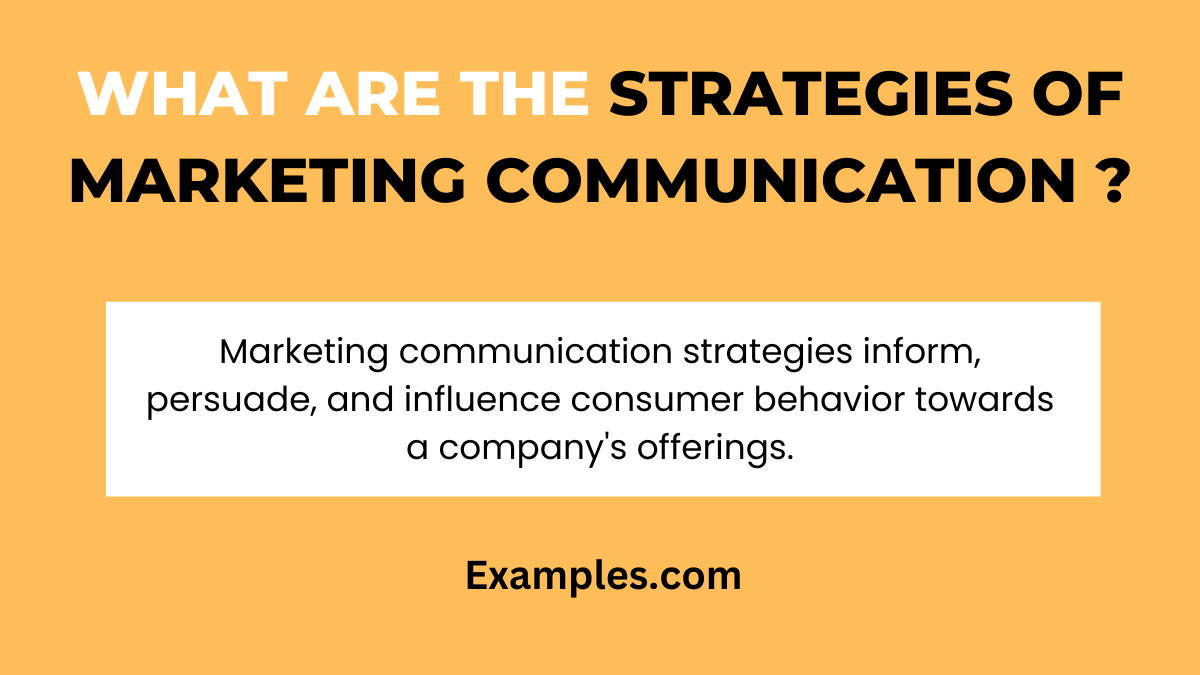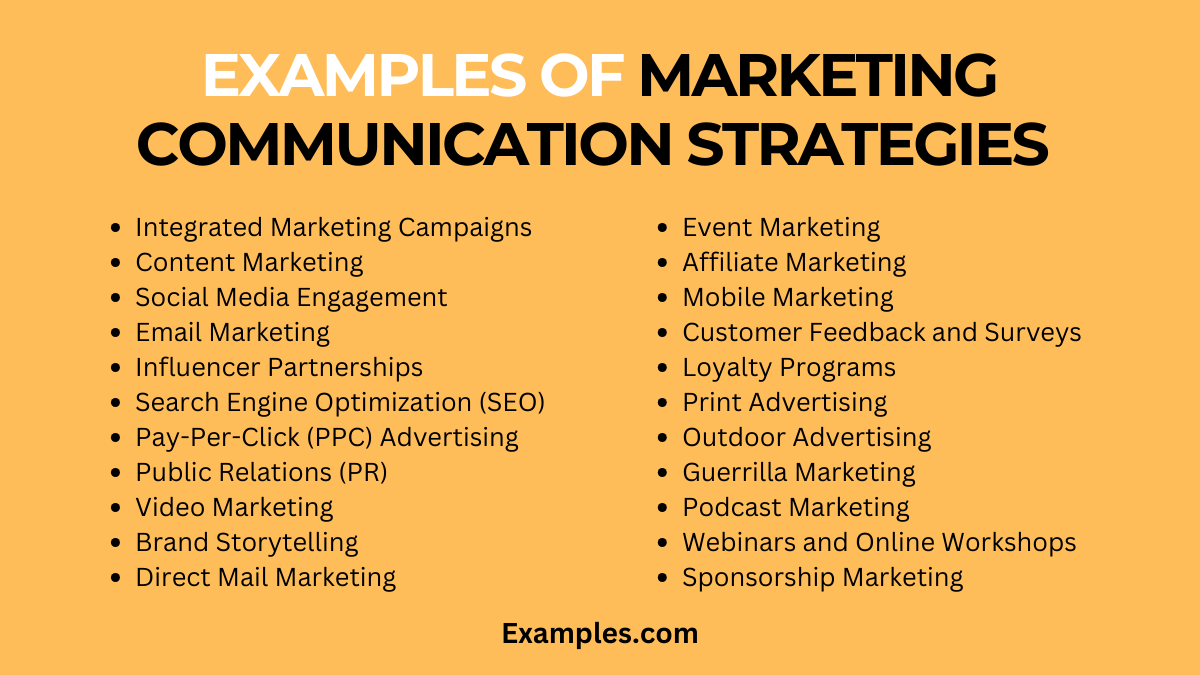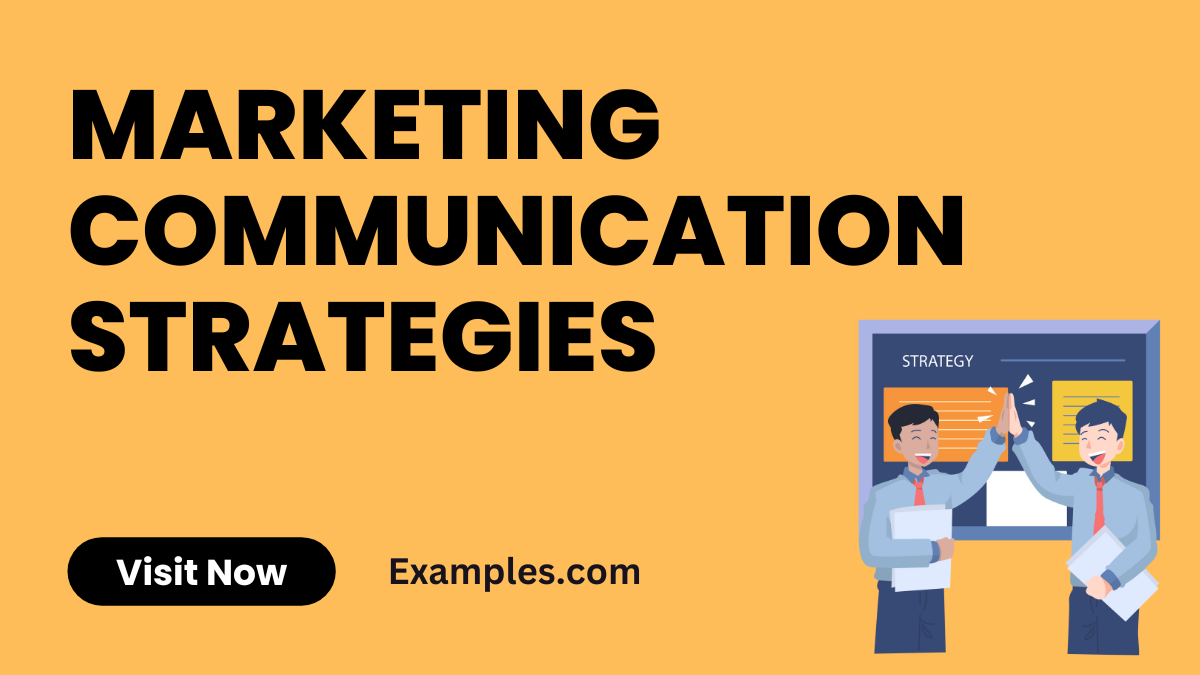24+ Marketing Communication Strategies Examples
Dive into the world of Marketing Communication Strategies with this comprehensive guide. Discover a range of effective tactics used by industry leaders, illustrated with practical Marketing Communication Examples. Learn how to craft messages that resonate with your audience and drive engagement. From traditional media to cutting-edge digital platforms, explore various strategies that can elevate your marketing efforts to new heights. Gain insights into how top brands successfully navigate the complex landscape of marketing communication, setting a benchmark for others to follow.
What are the Strategies of Marketing Communication ? – Definition

Marketing communication strategies are the methods and tactics used by companies to convey messages about their products or services to their target audience. These strategies aim to inform, persuade, and remind potential and existing customers about the company and its offerings. The ultimate goal is to influence consumer behavior, either to initiate a purchase, increase brand loyalty, or reinforce brand identity.
List of Marketing Communication Strategies

- Integrated Marketing Campaigns: Blend multiple communication channels for a cohesive marketing strategy.
Example: Use a mix of social media, email, and traditional advertising to promote a new product launch. - Content Marketing: Create valuable, relevant content to attract and retain a targeted audience.
Example: Develop a series of educational blog posts related to your product, providing useful information to your customers. - Social Media Engagement: Utilize social media platforms to engage with your audience and build brand loyalty.
Example: Run interactive social media campaigns encouraging user-generated content. - Email Marketing: Send targeted emails to nurture leads and keep customers informed.
Example: Design a monthly newsletter highlighting new products, company news, and special offers. - Influencer Partnerships: Collaborate with influencers to reach a broader audience.
Example: Partner with a well-known influencer in your industry for product endorsements. - Search Engine Optimization (SEO): Optimize your online content to rank higher in search engine results.
Example: Incorporate relevant keywords into your website content to improve visibility in search results. - Pay-Per-Click (PPC) Advertising: Use paid ads to drive traffic to your website.
Example: Set up a Google AdWords campaign targeting specific keywords related to your business. - Public Relations (PR): Manage the spread of information between your company and the public.
Example: Issue press releases to announce major company milestones or product launches. - Video Marketing: Engage your audience through compelling video content.
Example: Create a series of how-to videos demonstrating your product’s features. - Brand Storytelling: Share your brand’s story to connect emotionally with your audience.
Example: Develop a brand video that tells the story of your company’s origins and values. - Direct Mail Marketing: Reach customers directly through postal mail.
Example: Send personalized postcards with special offers to loyal customers. - Event Marketing: Promote your brand through events, webinars, or workshops.
Example: Host a webinar on a topic relevant to your industry to engage with potential customers. - Affiliate Marketing: Partner with other companies to promote each other’s products.
Example: Establish an affiliate program where bloggers and websites can earn commissions for referring customers. - Mobile Marketing: Reach your audience through mobile devices with apps, SMS, and more.
Example: Develop a mobile app that offers unique functionalities related to your product. - Customer Feedback and Surveys: Gather customer insights to improve your marketing strategies.
Example: Conduct online surveys to understand customer preferences and improve your product offerings. - Loyalty Programs: Encourage repeat business with rewards for loyal customers.
Example: Introduce a loyalty card system that offers discounts or free products after a certain number of purchases. - Print Advertising: Use traditional print media for targeted advertising.
Example: Place an ad in a popular magazine within your industry. - Outdoor Advertising: Capture attention through billboards, posters, and other outdoor media.
Example: Launch a creative billboard campaign in high-traffic areas. - Guerrilla Marketing: Implement unconventional marketing strategies to create a buzz.
Example: Organize a flash mob in a busy public area to promote your brand. - Podcast Marketing: Engage your audience through informative and entertaining podcasts.
Example: Start a podcast series discussing industry trends and featuring guest speakers. - Webinars and Online Workshops: Educate your audience and generate leads through online events.
Example: Host a series of free webinars offering valuable insights related to your product. - Sponsorship Marketing: Sponsor events, teams, or influencers to gain visibility.
Example: Sponsor a local sports team and feature your logo on their kit. - Community Engagement: Build brand loyalty by engaging with your local community.
Example: Participate in community service events and feature them on your social media. - User Experience (UX) Optimization: Enhance the user experience of your website or app.
Example: Redesign your website to make it more user-friendly and visually appealing. - Trade Shows and Exhibitions: Showcase your products and network with industry professionals.
Example: Set up a booth at a leading industry trade show to display your products.
Key Elements of Marketing Communication Strategies
- Message Creation: Crafting a clear, compelling message that resonates with the target audience. This involves tailoring the content to meet the needs and interests of the audience while effectively conveying the brand’s value proposition.
- Channel Selection: Identifying the most effective communication channels to reach the target audience. Channels can vary widely, from traditional media like television and print to digital platforms such as social media, email, and websites.
- Audience Targeting: Understanding and segmenting the audience to deliver more personalized and relevant messages. This segmentation can be based on demographics, psychographics, behavior, or other characteristics.
- Consistency: Ensuring a consistent message across all channels and touchpoints. This consistency helps in building a strong, recognizable brand image.
- Feedback and Adaptation: Monitoring the effectiveness of communication strategies and adapting them based on feedback and changing market dynamics. This involves analyzing metrics to understand the impact of different strategies and making necessary adjustments.
Effective marketing communication strategies are not static; they evolve with changing market conditions, technological advancements, and consumer preferences. Businesses must stay attuned to these changes to maintain effective communication with their audience.
In conclusion, effective marketing communication strategies are pivotal for any successful business. By incorporating these diverse approaches, from content marketing to influencer partnerships, companies can significantly enhance their outreach and engagement with target audiences. Remember, the key is to understand your audience and choose the strategies that resonate most with them, ensuring your marketing efforts yield the best results.



